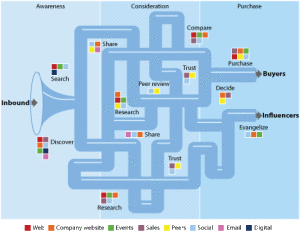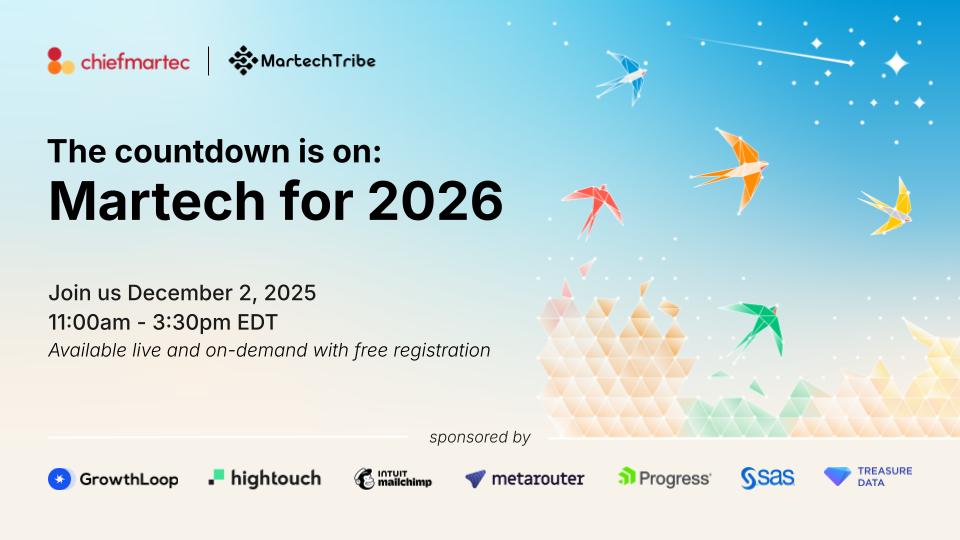
The funnel model of marketing and sales doesn’t reflect reality very well. We know this.
Buyers don’t proceed in lock-step fashion down a pipeline. They never did, actually. But the wide-ranging journeys of exploration that buyers can take today on the web have only exacerbated the disparity between the model and reality.

This more realistic diagram of the “funnel” by Lori Wizdo of Forrester Research brilliantly illustrates that point. The real funnel doesn’t look like a funnel at all. It looks like a tangled morass of plumbing. But we’re better off managing that reality than playing ostrich to the complexity of modern marketing.
But again, we know this.
Yet still the language of the funnel persists in marketing. We talk about the top of the funnel, the middle of the funnel, and the bottom of the funnel. We use rhymed abbreviations of TOFU, MOFU, and BOFU respectively.
Why? Mostly inertia. The path of least resistance is to keep calling these stages what we always have — even if the stages, and the way in which they’re framed together, have evolved significantly. Inventing new nomenclature, it could be argued, simply confuses people. Keep it simple. Keep with what we know.
But I’d like to make the argument in favor of something better for three reasons:
- The funnel shape doesn’t reflect reality (we know this).
- The funnel is missing two important stages of marketing.
- The funnel has negative connotations.
The first issue we’ve already acknowledged.
The second issue is that the funnel ends as soon as someone either becomes a customer or chooses a competitor instead. From that point onward, the buyer is off the edge of the map. But the opportunities to grow existing customers and make them advocates of your brand — and the opportunities to win over lost prospects further down the road — are important moments in the buyer’s lifecycle. Marketing should use a model that recognizes them.
The third issue is its tone. The funnel is a somewhat negative way of framing the progression of buyer relationships. Its design filters people out, a process of exclusion. People who buy are pushed to the very bottom. And the abbreviations. Ugh. TOFU sounds like, well, bean curd. MOFU, not to be crude, but there are vulgar interpretations for what that could stand for. And BOFU, um, sounds like “boffed you.” Not exactly a respectful connotation.
I know, I’m reading a little too much into the funnel. But language affects our perceptions. As marketers, we know that better than most. It would be nice if the model we used to describe customer relationships had a more positive vibe.
Proposed 5 stages of the buyer’s journey
I agree with Lori and others who have recommended that we frame the progression of these relationships as the buyer’s journey rather than the marketing funnel or purchase funnel. Right away, it’s a more customer-centric — rather than marketer-centric — view.

Within the buyer’s journey, I propose there are five stages:
- Start of Journey (SOJO)
- Middle of Journey (MOJO)
- Conversion of Journey (COJO)
- Rejuvenation of Journey (ROJO)
- Diversion of Journey (DOJO)
The first three are roughly analogous to the top, middle, and bottom of the funnel.
But there are subtle differences. The inner stages are drawn like less of a filter and more of a flow. The middle reflects a more wavy journey rather than a purely linear funnel. And instead of putting our likeliest candidates at the “bottom,” we identify later-stage prospects as being at a conversion point in their journey — converting from prospects to customers.
But the conversion of a prospect into a customer, or even their loss to a competitor, is not the end of their journey. It’s the beginning of the next stage.
If we won their business, our marketing responsibility to them has not ended. We want to make sure that they have a great experience as a customer — for they will share their experiences with others. We want to earn repeat business and grow the account. All these objectives fit under the heading of ROJO, the Rejuvenation of Journey. We want to continually rejuvenate relationships in this stage.
If we lost the customer to a competitor, however, that isn’t the end of the journey either. We want to be supportive and ideally remain as a resource to them. After all, they may chose to defect from that competitor in the future. And even if they don’t, they may still influence other buyers. For both reasons, we want to treat that stage as a delicate but special stage of our relationship with them.
We should view this as a Diversion of Journey (DOJO) — they’ve been diverted from a customer relationship with us. But our paths may very well have the opportunity to intersect further down the road. We want to be ready with open arms.
For what it’s worth, I can’t think of obvious negative connotations for any of these labels or abbreviations. I really like MOJO, since that’s where the heavy lifting of marketing is done — good to have marketing mojo. ROJO, if read as rojo in Spanish means red, making me think of existing customers as the lifeblood of the organization. And DOJO brings to mind images of a dojo, where we face an opponent (a competitor) more directly.
What do you think?



Great post Scott.
I have been trying to draw an alternative to the standard Funnel for ages, as clearly the funnel is nonsense, the product of some academics sterile notion of a process. Now I do not have to look any further.
Thanks
Allen
Thanks, Allen — glad to hear this resonated!
Nice graphic. Your observation on converting customers to advocates who could rejuvenate the funnel again is a critical one. In fact you could even imagine a customer to advocate funnel that continues running in its own track but still feeds more customers into the original funnel
Thanks, Abdallah.
Yes, I completely agree with you about post-conversion (regardless of if the conversion was a win or not) opportunities. I was trying to find a way to illustrate that without getting too complicated — which is why the ROJO stage has two loops, one meant to imply repeat business from that customer and the other meant to imply advocacy that feeds other prospects into SOJO/MOJO stages.
Any suggestions for people whose nickname is the “Funnelholic”?
This is a great post (of course) and a great graphic. I almost feel like I could not create a comment that comes remotely close to the intelligence in your writing. Great stuff.
Recovering Funnelholic? 🙂
Thank you for the kind kudos, Craig. Given your experience and insight in this space, I’m very happy to hear that you like this.
Hi Scott,
I am all with you. We all use different names. Some call it the buying cycle, others the customer life-cycle or customer journey. These names do not really matter. What matters to me as a marketer in B2B, is to better understand what my marketing actions actually do with respect to the behavior of our customers.
What I have found that is having a certain model available in your marketing operations is useful. It is useful because everyone is now on the same page. When you have content, or automation decision to be made, or conversion actions to be developed, it helps to be able to refer to ‘awareness phase’ or ‘start of journey’ as you call it.
Next to having all people in your team using the same wording, the nice thing of having a model is that you are more aware of what you are doing. Once you start measuring and putting all of your actions along this cycle, you start understanding where you need to improve, or where you have a disconnect.
Anyway, so far my 5 cents.
thanks,
Tom
Thanks for the great comment, Tom.
Yes, I agree with you on both counts: names don’t matter unto themselves, but having a cohesive model for your organization to synchronize around is extremely valuable.
The most important thing with the “journey” model is to have a complete enough picture that it isn’t missing any essential stages. What I’m referring to as Rejuvenation and Diversion — and others have labeled differently — seem to be useful parts that the traditional funnel lacked.
Yet still, MOJO does inspire me more than MOFU. 🙂
Great point – I don’t care what you call it as long as you have spent some time mapping it out and making sure that everyone on your team understands what it means to them in order to achieve the business goals.
There seems to be a lot of companies that see a model, claim it as their own yet fail to sit down and discuss what it means in terms of communication, messaging, offers etc.
Terrific post Scott.
While we talk about this reality and plan against it, your model/visualization does an amazing job of clarifying it.
Once your content and program are organized against
-Start of Journey (SOJO)
-Middle of Journey (MOJO)
-Conversion of Journey (COJO)
-Rejuvenation of Journey (ROJO)
-Diversion of Journey (DOJO)
you can see the journey happening in your marketing automation metrics and manage your performance against how your real pipeline is working.
Love your model, just love it!
Scott Armstrong
Brainrider – Better B2B Marketing
Nice! If you have a case study of marketing automation metrics aligned to this model at some point, I’d be thrilled to hear about it and feature a post on it.
Love your articles, Scott!
As someone who is involved in the reporting and analytics of the buyer’s journey (and subsequent optimization of said journey), I’ve found that it is ok to use overly simplistic visualizations of complex processes if it helps communicate your points better. All visualizations are models, and all models are simplistic but imperfect representations of reality.
So while your Sales Manager only needs to communicate in terms of the funnel most of the time, Marketing Execs need to use slightly more comprehensive models/visualizations to describe the complex activity they are responsible for optimizing. What you’ve shown here is a Sankey Diagram which takes the funnel and sort of drills down to the next level.
The penultimate visualization of the buyer’s journey would be a network diagram (but accessible data and convenient tools are both problems with creating such a visualization). Each vertex represents an interaction point and the length/thickness of each edge represents the volume of traffic between each vertex. This view would be useful for your tactical level of marketing managers.
What does this mean for the future of the logo for chiefmartec.com (the multi colored funnel at the top of the page)? Are you going to ditch the funnel for a sankey?
Thanks, Isaac — much appreciated!
Very good point that different models/visualizations serve different audiences and purposes. One of the advantages of the funnel has been its simplicity for broader discussion within the company. Although I do think the connecting the traditional funnel pipeline with the “rejuvenation” stage of existing customers is an important piece for company-wide discussions as well.
“Sankey Diagram” sounds more official than “fish diagram” or “French horn,” which are the other two characterizations I’ve heard for this SOJO –> ROJO illustration.
Maybe I should start positioning my logo as more of a tornado — in reference to Geoffrey Moore’s “Inside the Tornado” book — instead of a funnel.
Hi Scott,
I love the way you think and write and you have great MOJO!
As Austin Powers would say, “Groovy!”
This is marvelous. I’ve used various derivations of funnels for years — not because I thought they were the most accurate description of a consumer’s journey — but because alternative frameworks were too convoluted to be actionable. I can’t wait to dive in and give this framework a “test-drive.”
Good article and much more intelligent than anything I have seen on the Funnel for ages.
My only comment/question is that with greater understanding and realisation that buyers can’t be forced into a nice neat sales process, aren’t we rapidly approaching a point where it will become so difficult to even attempt mapping and predicting behaviour on the part of buyers that in reality the only thing we can do is starting responding to changes in buyer behaviour as it happens? That sounds quite negative, but I don’t mean it to. I am merely suggesting that this kind of more realistic flexible view of ‘funnel’ makes complete sense especially if it acknowledges that practically every buyer is going to go through a unique journey with only their behaviour during the journey as a guide.
Great article Scott!
Funnels always seemed like a misnomer to me in that people don’t use funnels that way. Everything we pour into a funnel comes out the other end, so nothing is ever filtered out. Although there are many different analogies available, losing the association to funnels is a good idea. I believe we have grown out of them.
The one truth in the funnel analogy is that people came in, so focusing on journey is quite apt. You did great work here and using 5 areas seems to cover it very well.
I’ll put a suggestion out there. Lets observe people at a different angle. Top down.
If we could view people the old way, in funnels, they would be sliding through with no traction, no control. Not how people behave – because they have choice and generally only enter when footing is good.
If we picture people moving through diagrams, we again expect that enough people will follow the flow to make our analysis relevant. This fact should remain constant for diagrams however it does not play to peoples choice because it may create boundaries in the wrong places.
Boundaries could be at the outside edges of the over all buyers journey. We might then take away the white space in our diagram so that only the 5 areas remain.
With boundaries at only the outside edges and no more white space let’s now view the process as it lies flat on the floor, top down as opposed to on the wall.
Now we can recognize people as having their feet in contact with one area or another. When we observe people in control of their choices we can add the context of those choices to our work.
We can take tangible observation to the decision making process in content generation and product development.
Respecting the control people have in the models of marketing and sales is much improved with the 5 areas of the customer journey
Okay, I just have to say, the reason the funnel worked well is because its shape helped visualize the fact that at each stage of the sales process, there are less and less participants. Everybody understood that the funnel metaphor breaks down if the only way out is the hole at the bottom.
And now that we are getting creative, let’s face it, we are not there yet. Most sales folks and sales manager don’t even know where there is. They are too busy looking at the funnel I guess. But a perfect model will have the following attributes:
– Visualize how many participants exist at each stage of the sales process
– Visualize where the participants have moved since the previous report
– Visualize the ETA of anyone and everyone toward a closed sale
– Visualize the dollar amount of each participant and the total amount at each stage
– Visualize the number of participants, dollars, and reasons for each dropout since the previous report
Am I forgetting anything? Its been a couple hours since I closed my last sale.
Thanks for the informative article! There’s something more human about a non-symmetric, inter-connecting model (and we are humans, after all).
Scott, that the funnel doesn’t “work” any longer as a description of what actually happens in the so-called sales process is, as you say, well known by now. (“But again, we know this.”) But maybe that’s because we’re still looking at this as a process, which must indeed have some form of beginning, middle, and end (even where the end represents some new kind of beginning).
That’s why I see little value in your newer version of the process, because it’s still a process, and a marketing and sales process. I think the better metaphor, which looks at this faux process from the person on the Web’s point of view — neither consumer, nor customer, nor prospect — is something that a Yahoo research paper from years back called the long and winding road. Tough as it is for us, as marketers, to appreciate, but the journey to sales and/or advocacy, is over-determined by a multitude of factors and experiences that just won’t fit comfortably into either a funnel or sales “journey.”
Of course, we all know this when we think of our own behavior.
Great insight here Scott! It’s so relevant that I thought you wrote this today. Our CMO, Sangram Vajre, recently proposed a different spin on this concept called “Flip My Funnel.” The idea is that you start with your target customers first and focus solely on them wherever they are in the process. By doing this, marketers can maximize their effectiveness and drive more revenue. You can check out the elaboration of this here: http://terminus.com/blog/flip-my-funnel/